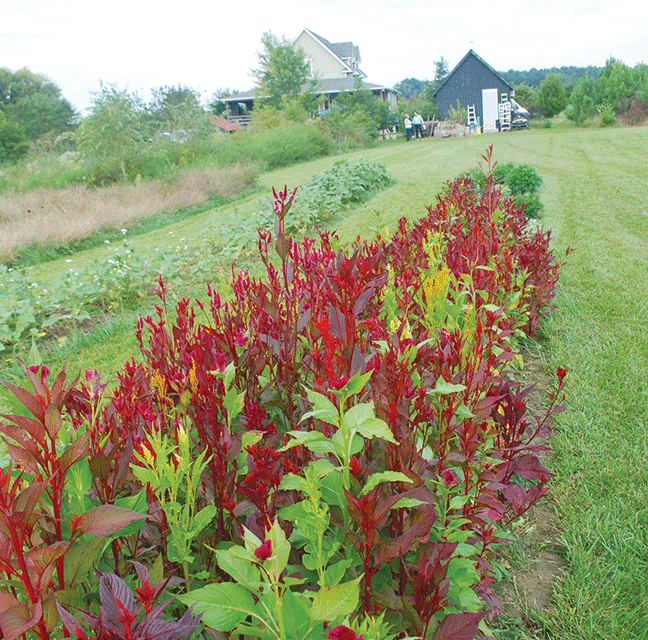By Carol Kinsley
In 2009, Chris and Carrie Jennings purchased five acres of former cornfield in Cordova, Md., just 10 minutes from Easton. Chris, a cabinet maker, built a beautiful home there.
“There were three trees on the property,” noted Carrie, who has a degree from Virginia Tech in environmental policy and planning with an emphasis in forestry.
While working full-time for Queen Anne’s County Soil Conservation District as agricultural resource conservation specialist, she set out, with Chris’ help, to create a dream landscape which includes fields of flowers and flowering trees where honeybees would have plenty of nectar.
Together they created Honeybee Flower Farm.
They started with trees.
They planted a windbreak with help from the Environmental Quality Incentives Program through USDA, a voluntary conservation program that provides farmers with financial cost-share assistance and technical assistance to implement conservation practices on working agricultural land.
“We planted close to 1,000 trees,” Carrie told visitors at a recent Maryland Commercial Cut Flower tour sponsored by University of Maryland Extension.
“The vast majority were purchased from the Maryland Department of Natural Resources state tree nursery as 12-inch seedlings.”
Unfortunately, she added, “they were planted during what turned out to be the worst drought since 1956.”
Undeterred, they kept planting. Carrie worked in landscaping and as a personal gardener prior to her job.
This time, the work was to fulfill the young couple’s passions.
When their new home was completed, they put in lots of foundation plants, which are used for cut flower arrangements.
“We don’t grow a lot of woodies,” Carrie said. “We have hydrangeas scattered through the garden.”
Honeybee Flower Farm opened during the spring of 2012, with the goal of providing the local community with long-lasting, colorful, field-grown specialty cut flowers.
“Our flowers aren’t shipped in from overseas, eliminating the carbon footprint and helping to support our local community. Much of the necessary supplies, tools, and machinery we use to grow our flowers are purchased from businesses located on the Delmarva Peninsula,” Carrie said.
“About 25 percent of our plants are perennials,” she continued. “I start everything from seed, starting them indoors. We have grow lights downstairs.”
It’s good to plant a variety of flowers, Carrie advised, especially the “come and cut again” kind.
For summer and fall, she grows flowers from A to Z — Asiatic lilies to zinnias.
She grows many varieties of pollenless sunflowers, mountain mint, dianthus, cosmos, Oriental lilies, monarda, celosia, rudbeckia, hydrangea, gladiola, ageratum, statice, vitex, hyacinth bean vine, forget me not … the list goes on and on.
She welcomes garden clubs for tours and even offers the wide, wrap-around porch of their home for the club to conduct its business meeting.
May and June are the prettiest months for tours, she said.
Ultimately, Carrie’s dream is to be able to concentrate on her flower business full-time.
Until then, there is a lot of work to be done.
Weeds, of course, are a problem, particularly when you don’t want to use a lot of herbicides.
Chuck Schuster, University of Maryland Extension education for commercial horticulture, who visited with the cut flower tour, warned the Jennings, “You will have a problem with Bermuda grass. Some of the best control for Bermuda grass is Pylex herbicide, mixed with triclopyr.” The suggestion came with a caution that the combination provides “total kill, but the area will be out of production for six to eight months.”
The Jennings have used some herbicide around their trees, but not on the rows of flowers. “They’re packed in too tightly,” Carrie said.
They haven’t had as much problem with deer as from voles. “We found holes in our irrigation lines,” Chris said. “Last year voles made holes every 4 inches in every line.”
Their barn cat helps with the vole problem.
A few free-range chickens also help with insects and provide not only fresh eggs but manure for the compost pile.
“We need more organic matter,” Carrie said. They plan to buy a dump trailer for sourcing local organic material.
Chris built a walk-in cooler, which is already too small. It keeps the temperature down to 39 degrees. “Someday I’ll build a proper shop with a professional cooler,” he promised.
They spent $2,000 for a 1972 Satoh Japanese tractor with a gas motor. “It runs like a tank,” Chris said.
They had started with a 1935 Ford 8N, but it “wasn’t ideal.”
A new van is being equipped to handle deliveries. “Carrie wants more shelves,” Chris told visitors.
Shelving is a problem because a lot of flowers are really tall.
He is trying to make the interior flexible.
A 2,000-square-foot high tunnel extends the season, making it possible to provide early blooms of ranunculus in March, for example, and colorful flowers for Thanksgiving tables in fall.
With a name like Honeybee Flower Farm, there must be bees, and there are. The couple has two hives at present, but they’ve only tried to collect the honey once.
“I scraped the honey off the frames,” Carrie said, “but I realized we need a centrifuge to wick the honey off the frames. My sister enjoyed the honey. She didn’t mind the bits of wax.”
For now, the bees earn their keep as pollinators and the emphasis of Honeybee Flower Farm is on the flowers.




